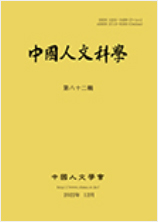학술논문
16∼18C 古詩選集에 반영된 漢代民間樂府의 選錄현황과 의의
이용수 0
- 영문명
- 발행기관
- 중국인문학회
- 저자명
- 김희경
- 간행물 정보
- 『중국인문과학 』제76집, 255~274쪽, 전체 20쪽
- 주제분류
- 인문학 > 문학
- 파일형태
- 발행일자
- 2020.12.31
5,200원
구매일시로부터 72시간 이내에 다운로드 가능합니다.
이 학술논문 정보는 (주)교보문고와 각 발행기관 사이에 저작물 이용 계약이 체결된 것으로, 교보문고를 통해 제공되고 있습니다.

국문 초록
영문 초록
As the folk’s Yuefu poems in Han Dynasty have the unique foundation called “Mingachaejib”, they have several characteristics to be noted. The characteristics include the fact that there are many folk’s Yuefu poems whose authors are not known but which are written by ordinary people and that they reflect the social situation during Han Dynasty. As for the transmission of the actual social reality, they had strong narrativity as these truthful stories of the ordinary people’s poetry, and they used the unique words and were free style for folk’s Yuefu poems only, which has contributed to the development of the future history of poems. To find out the evaluation by poets of Qing Dynasty of folk’s Yuefu poems having unique attractiveness of Han Dynasty, this study select 4 kinds of collection of old poems. The “Gosigi” or the collection of old poems written during Han Dynasty and “Chaesukdanggosiseon”, “Gisiwon” and “Gosisangseok”, which were the collections of old poems written during Qing Dynasty are all the collection of poems by type. They all have the poems written from early Zhou Dynasty to Sui Dynasty. In addition, from the perspective of the completion time, they were all written during 16th ~18th century. The types, numbers and common list of the folk’s Yuefu poems of Han Dynasty from 4 collections of old poems were summarized and, based on the summary, several characteristics are found. First, the biggest difference in perception was found in “Japgayosa”. Among 4 collections of old poems, only “Chaesukdanggosiseon” did not contain any japgayosa” but it contained the “Gyomyogasa” the most. But, if viewed from the flow of collection of old poems other than that, it had more types of folk’s Yuefu poems which were uniformly allocated and its rate of selection of japgayosa was not low. Second, the “Gyomyogasa” in the common selection list are related to the ancestral rites, and it showed less selection rate than the collection of old poem of Gosigi except Chaesukdanggosiseon as the time passed down. Third, among the common selection list, the “Sanghwagasa” takes the most ratio and showed more selection rate than the collection of poems “Gosigi” in later years. This happens because the characteristics from the unique “Mingachaejip” are mostly exposed in the Danghwagasa, thus attracting the interest of recorder. Fourth, the selection rate of “Japgokgasa” in the common selection list has increased in the collection of poems written in later days than in the collection of poem “Gosigi”. That also showed that people were more interested in the works reflecting the society of that time as shown in the case of Sanghwagasa. Though the Gochwigoksa was the military song, its contents were not limited to the war but were more related to the love between men and women. Therefore, they are less posted in the Gosiwon written by Shen Deqian, who argued the motto of ‘onyudonghu’ but opposed to the ‘buyeom’ as well as in “Gosisangseok” which succeeded that. In the common selection list of 4 collections of old poems, the “Sanghwagasa” took up the most part because the recorder found out that the characteristics from ‘Mingachaejip’ were displayed in the ‘Sanghwagasa’ the most. It shows that what the scholars who selected the poems for 4 collections of poems written in 16th ~ 18th century wanted to see the reality and true social life of people lived in Han Dynasty through the folk’s Yuefu poems of Han Dynasty.
목차
Ⅰ. 서론
Ⅱ. 16∼18C 4종 古詩選集의 民間樂府수록 현황
Ⅲ. 16∼18C 4종 古詩選集의 民間樂府공통 選錄목록을 통한 분석
Ⅳ. 결론
키워드
해당간행물 수록 논문
- 중국어 독해 교육 방안 연구
- 淸代後期西洋宣敎師가 學習한 北京官話홍 홍
- 《经国美谈》译本的翻译研究
- 張恨水소설의 中階문학 성격 고찰
- 《鲁迅小说全集》韩译本翻译策略及技巧研究
- 말레이시아 화문교육(華敎)의 메커니즘
- 《老子》의 接續詞用法考察
- ‘一’字관련 불교 어원의 중국어 성어 小考
- 중국인문과학 제76집 목차
- 타이완 2․28의 前兆와 그 실상
- 蘇廙《十六湯品》의 사료적 가치와 의의
- 노자의 수사학(2)
- 미래 상황에서 쓰이는 “了”와 “-었-”의 대조연구
- 漢語變調構詞와 閩南語文白異讀의 音義關係에 대한 小考
- 중국 직업교육 시스템의 해외진출 전략 탐색
- 略论吴乔的宋诗学思想
- 도시와 문화, 문화도시와 도시문화
- An Analysis of Chinese Prescription Translation of A Dream of Red Mansions from Domestication and Foreignization Theory
- 基于移动互联学习方式的汉语L2学习产品设计方案: 面向韩国汉语学习者的线上汉语学习产品可行性分析
- 中國人文學會 會則 외
- 근대 중화질서의 재편과 조선 인식의 변용
- 16∼18C 古詩選集에 반영된 漢代民間樂府의 選錄현황과 의의
- 동진부학이론 연구
- 大观园原型“水西庄说”述评
- ‘上善若水’와 ‘天下至誠’에 대한 小考
- 一廟二城隍: 上海城隍廟의 諸神속성과 기능 연구
참고문헌
교보eBook 첫 방문을 환영 합니다!

신규가입 혜택 지급이 완료 되었습니다.
바로 사용 가능한 교보e캐시 1,000원 (유효기간 7일)
지금 바로 교보eBook의 다양한 콘텐츠를 이용해 보세요!





